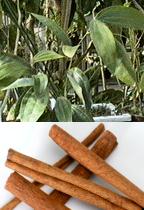| Cinnamon ... and Diabetes |
|
It seems that you should take cinnamon from your spice rack and stick it in your medicine cabinet.
It's been used as an herbal medicine for over a thousand years.
Made from the bark of a small Southeast Asian evergreen tree, it comes in oils, a powder or in rolls called quills.
The Chinese have used it for thousands of years for stomach, liver conditions, infantile diarrhea, influenza, parasitic worms and flatulence, and in Roman times ... |  cinnamon plant and quills |
Pay attention!
>Okay, but what's all this got to do with diabetes?
Recently, University of California researchers have been studying the effects of cinnamon on diabetic mice, which have
been fed water laced with cinnamon. They concluded that:
""Cinnamon has insulin-like activity and also can potentiate the activity of insulin. The latter could be quite important in treating those with type 2 diabetes. Cinnamon has a bio-active component that we believe has the potential to prevent or overcome diabetes."
Type 2 diabetes, the most common form, is when your body can't produce enough (or cannot use) insulin.
It's insulin (produced in the pancreas) that takes sugar from blood to cells where it's a source of energy.
Excess sugar is stored in your liver.
Too little insulin? Too much sugar in your blood!
A U.S. Dept. of Agriculture human study with 30 test subjects with type 2 diabetes (who took 1 to 6 grams of cinnamon extract daily) indicated that, after only 40 days of taking cinnamon, they had a significant decrease in blood glucose, triglycerides, LDL, and cholesterol.
A lead scientist at the Human Nutrition Research Center in Beltsville, Md., has been studying cinnamon and calls its medicinal properties the most significant nutritional discovery he's seen in 25 years.
Although the research isn't conclusive (yet), it suggests that cinnamon escorts blood sugar into the cells, making them more sensitive to the insulin that's availabe.
"An active ingredient in cinnamon, proanthocyanidin, worms its way inside cells, where it activates the insulin receptor. Once this receptor is activated, whether by insulin or cinnamon, chemical reactions occur allowing the cell to use energy from sugar."
So a diabetic might consider taking some cinnamon and ...
>But consult your doctor first, right?
Yes, however, when I was told that I was a borderline diabetic and I wrote that stuff on ...
>That Glycemic Index stuff, right?
Yes, so I'm cautious about my sugar intake.
The Missus buys me dietetic ice cream (with
Splenda replacing sugar)
and I've started sprinkling cinnamon on ...
>On your ice cream, right?
Yes. Anyway, since there's a chance that cinnamon will decrease blood sugar levels, I'm going to keep track, just to see ...
>See if it goes down, right?
Stop interrupting!
|
Anyway, a "normal" blood glucose level is about 4 millimoles per litre.
mmol/l is the world standard measure. It's used everywhere ... except in the U.S. !! If it gets as high as 6, you may be prediabetic. If it gets to 7 or higher ... pray. So, I started with the cinnamon stuff on Feb 19, with cinnamon on my icecream.
>That proves it, right?
|  |

